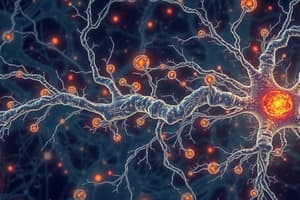Podcast
Questions and Answers
What is a synapse?
What is a synapse?
A synapse is the region where a presynaptic neuron connects and transmits signals to a postsynaptic neuron.
What term is used to describe the connection between a neuron and a muscle?
What term is used to describe the connection between a neuron and a muscle?
The connection between a neuron and a muscle is called a neuromuscular junction.
What are the two main types of synapses?
What are the two main types of synapses?
The two main types of synapses are chemical and electrical synapses.
What is synaptic delay?
What is synaptic delay?
What are the three components of a synapse?
What are the three components of a synapse?
What are the types of synaptic vesicles and their contents?
What are the types of synaptic vesicles and their contents?
How are synaptic vesicles transported within a neuron?
How are synaptic vesicles transported within a neuron?
What process allows vesicles to release neurotransmitters?
What process allows vesicles to release neurotransmitters?
What is the kiss-and-run discharge process?
What is the kiss-and-run discharge process?
What role do voltage-gated Ca2+ channels play in neurotransmitter release?
What role do voltage-gated Ca2+ channels play in neurotransmitter release?
How do neurexins contribute to synaptic organization?
How do neurexins contribute to synaptic organization?
What effect do neurotoxins from Clostridium tetani and Clostridium botulinum have on neurotransmitter release?
What effect do neurotoxins from Clostridium tetani and Clostridium botulinum have on neurotransmitter release?
What occurs when Cl− ions enter a neuron?
What occurs when Cl− ions enter a neuron?
What characterizes slow EPSPs and IPSPs?
What characterizes slow EPSPs and IPSPs?
What is the primary feature of electrical synapses?
What is the primary feature of electrical synapses?
How do fast excitatory postsynaptic potentials (EPSPs) affect neuron excitability?
How do fast excitatory postsynaptic potentials (EPSPs) affect neuron excitability?
What is the primary effect of presynaptic inhibition on neurotransmitter release?
What is the primary effect of presynaptic inhibition on neurotransmitter release?
Which neurotransmitter was first identified to cause presynaptic inhibition?
Which neurotransmitter was first identified to cause presynaptic inhibition?
What role does Ca2+ play in presynaptic facilitation?
What role does Ca2+ play in presynaptic facilitation?
What is the neuromuscular junction?
What is the neuromuscular junction?
What happens when acetylcholine binds to nicotinic receptors on the motor endplate?
What happens when acetylcholine binds to nicotinic receptors on the motor endplate?
How does presynaptic inhibition affect K+ channels?
How does presynaptic inhibition affect K+ channels?
What initiates the release of acetylcholine from synaptic vesicles?
What initiates the release of acetylcholine from synaptic vesicles?
What is the role of baclofen in relation to presynaptic inhibition?
What is the role of baclofen in relation to presynaptic inhibition?
Flashcards are hidden until you start studying
Study Notes
Synapse
- Synapse: The point of connection between neurons, transmitting signals from one neuron to another.
- Neuroeffector Junction: A specialized synapse where a neuron communicates with an effector organ (muscle or gland).
- Neuromuscular Junction: A specialized type of neuroeffector junction where a neuron connects to a muscle fiber.
- Synaptic Transmission: The process of signal transmission across a synapse.
- Synaptic Delay: The minimum time required for synaptic transmission, typically 0.5 ms, attributed to neurotransmitter release and action on the postsynaptic neuron.
Chemical Synapse
- Presynaptic Terminal: The terminal end of the neuron that releases neurotransmitters.
- Synaptic Cleft: The space separating the presynaptic and postsynaptic membranes, about 20-40nm wide.
- Postsynaptic Density: An organized structure on the postsynaptic neuron containing receptors, binding proteins, and enzymes for receiving and processing neurotransmitters.
- Neurotransmitters: Chemical messengers stored in synaptic vesicles, released into the synaptic cleft to transmit signals.
- Types of Synaptic Vesicles:
- Small, clear synaptic vesicles: Contain acetylcholine, glycine, GABA, or glutamate.
- Small dense-core vesicles: Contain catecholamines.
- Large dense-core vesicles: Contain neuropeptides.
- Exocytosis: The process of releasing neurotransmitters from vesicles into the synaptic cleft by fusing with the cell membrane.
- Endocytosis: The process of recycling synaptic vesicles after release, refilling them with neurotransmitters.
- Kiss-and-Run Discharge: A mechanism where vesicles release contents through a small opening and quickly reseal, without full fusion with the membrane.
- Voltage-gated Ca2+ Channels: Located near the release sites, opening upon depolarization, allowing Ca2+ influx and triggering exocytosis.
- Neurexins: Presynaptic cell-adhesion molecules that bind to neuroligins on the postsynaptic membrane.
- Neuroligins: Postsynaptic cell-adhesion molecules that bind to neurexins on the presynaptic membrane.
- Neurexin-Neuroligin Interaction: Helps maintain synapse structure and ensure precise communication between neurons.
Electrical Synapse
- Gap Junctions: Low-resistance pathways formed between presynaptic and postsynaptic neurons, allowing direct ion flow.
- Fast Transmission: Enables faster communication between neurons compared to chemical synapses due to direct ion flow.
Presynaptic Regulation
- Presynaptic Inhibition: Decreases neurotransmitter release by reducing action potential strength at the presynaptic terminal.
- Presynaptic Facilitation: Increases neurotransmitter release by prolonging the action potential at the presynaptic terminal.
- Axoaxonal Synapse: A synapse where one neuron connects to the axon of another neuron, involved in presynaptic inhibition.
- GABAA Receptor: Activation increases Cl− conductance, contributing to presynaptic inhibition.
- GABAB Receptor: Activation increases K+ conductance, also involving presynaptic inhibition.
Neuromuscular Junction
- Terminal Boutons: Branching endings of the motor neuron, containing acetylcholine-filled synaptic vesicles.
- Motor Endplate: A specialized region of the muscle fiber membrane, receiving signals from the motor neuron.
- Sequence of Events at the Neuromuscular Junction:
- Depolarization of the motor nerve ending.
- Ca2+ influx into the nerve terminal.
- Acetylcholine release from synaptic vesicles via exocytosis.
- Acetylcholine binding to nicotinic receptors on the motor endplate.
- Na+ influx into the muscle fiber, causing depolarization.
- Triggering of muscle contraction.
Additional Information
- Deadly Toxins: Zinc endopeptidases can block neurotransmitter release by inactivating proteins in the fusion-exocytosis complex.
- Clostridium Tetani and Clostridium Botulinum: Bacteria producing toxins that disrupt neurotransmitter release, causing tetanus or botulism, respectively.
- EPSP: Excitatory postsynaptic potential, a brief depolarization, making the neuron more excitable.
- IPSP: Inhibitory postsynaptic potential, a brief hyperpolarization, making the neuron less excitable.
- Slow EPSPs and IPSPs: Occur in autonomic ganglia, cardiac and smooth muscle, and cortical neurons, with longer durations and distinct mechanisms involving K+ channels.
- Spasticity: Increased muscle tone and stiffness, potentially treated with baclofen, a GABAB agonist.
Studying That Suits You
Use AI to generate personalized quizzes and flashcards to suit your learning preferences.



